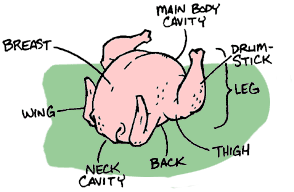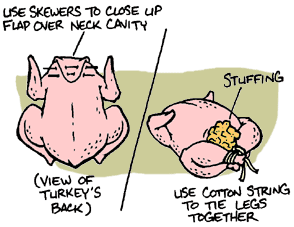Roast A Turkey
Some metal or wooden skewers
Some butter, margarine, or vegetable oil
Salt and pepper
Some aluminum foil
Cotton string
Optional
A flat rack that fits inside the roasting pan
Stuffing
Sage, bay leaves, or rosemary
A few carrots
Some onions
A few sticks of celery
Flour or cornstarch
wine, sherry, or milk
20 minutes to prepare a turkey. Approximately 18 minutes of roasting for each pound (.45 kilograms).
It's important to mix your stuffing shortly before you put it in the turkey.
Some experts claim that basting a turkey is ineffective. They say that the liquid barely penetrates beneath the skin. Nonetheless, hundreds of moms and chefs still swear by the process. If you are especially worried about having a dry turkey, you may want to baste it to put your mind at ease. That way, if anyone asks whether or not you basted, you can say yes.
The safest way to deal with leftover turkey, and to avoid any possible bacterial contamination, is to remove meat from the bones within two hours after the turkey is done roasting. Eat the turkey and stuffing within three days after roasting. If you store leftovers in the freezer, store the meat and stuffing separately. The stuffing will retain its optimum taste for one month, and the turkey will retain its best flavor for two months.
Roast a Turkey
So you're hosting a holiday meal, and you want to roast a turkey. But how do you even prepare one? You're worried it'll wind up dry, undercooked, or--heaven forbid--still frozen! Have no fear, we'll walk you through the steps that will make your dinner a success.
You can usually find a turkey at any grocery store, especially during holiday seasons, and they come either frozen or fresh. Some turkeys are labeled as "free range." This means they were allowed to freely roam on a turkey farm while they were alive, and didn't ingest antibiotics or hormones.
If you choose a frozen turkey, take into consideration how long it needs to thaw before roasting. Plan on two to three days for the turkey to properly thaw. How long it takes will depend on its size. Defrosting in the refrigerator is the safest way to handle poultry.
You'll also have to decide how big a turkey to get. Plan on 3/4 to 1 pound of turkey per diner. (If you want leftovers, don't forget to add a couple of hypothetical diners to the equation.)
Prepare the oven and the turkey

Before you start anything, preheat the oven to 325°F (163°C). A preheated oven will ensure even roasting and will help to seal in the turkey's natural juices.
Take your fresh or thawed turkey, and remove the wrapping from it. Next, remove the giblets and neck from the turkey's main cavity. (If you like, the giblets can be used in the gravy, or both can be used in making turkey soup later.) Clear off any extra fat in the skin. The turkey may be fairly juicy; if it is, pat it dry with paper towels.
If you're stuffing your turkey with dressing, now is the time. Stuff it into the main cavity, but don't pack it in too tightly, as it won't cook all the way through if you do. You can always put additional stuffing in the neck cavity if you want more stuffing in the turkey. It's also possible to bake stuffing on the side, in a separate dish. Some experts recommend this instead of stuffing the turkey, as the turkey roasts faster and it reduces health concerns about the stuffing or turkey being properly cooked.
If you're not using stuffing, you can put about 1.5 teaspoons of aromatic herbs such as bay leaves, rosemary, or sage in the turkey's cavities at this time. You can also add aromatic vegetables such as carrots, celery, and onions. Herbs and vegetables will improve the meat's flavoring. Make sure you clean the vegetables and remove any skin before placing them in the turkey. You might also want to cut them down into sizes that stuff more easily.
Truss the turkey
Whether or not you've put in stuffing, herbs, or vegetables, you'll want to keep the turkey juicy by closing up the cavities before roasting. Use metal or wooden skewers to fasten the loose flap of skin over the neck cavity. Tie the legs together in front of the opening of the body cavity to close it. (This can also be done with skewers.) When you do this, make sure your string is made of cotton. An acrylic or plastic string would melt during roasting.

Rub the turkey's skin with a generous amount of butter, margarine, or vegetable oil to create a crisp, brown skin while roasting. Lightly salt and pepper the outside of the turkey.
Set the turkey, breast side up, in a shallow roasting pan, or onto a shallow rack set in the roasting pan. The rack will let air circulate, creating a nice brown color all around the turkey, and also promote even roasting. Tuck the tips of the wings under the turkey, so you have a neat, compact turkey that will keep its juices in.
Roast a Turkey Part 2 .
The information and graphics on this webpage provided by the old http://tutorials.learn.com/custom/linkshare/linkshare.asp 